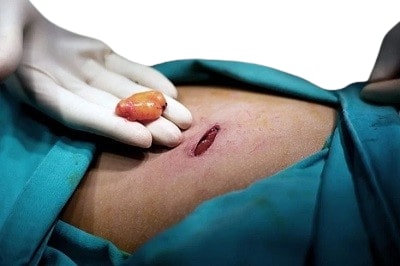Lipoma surgery Tunisia
What is a lipoma ?
 lipoma is composed mainly of fat cells and is a benign tumor that is composed of fatty tissue. It has a rounded or oval morphology, usually flexible, elastic and sometimes slightly firm, with a diameter that can vary from 1 to 20 cm. Typically, lipomas are isolated, although some patients may have multiple lipomas, known as lipomatosis. They can appear in different areas of the body such as the forearms, trunk, thighs and neck, mainly in adults aged 40 to 60 years. Although lipomas usually have no symptoms, they can sometimes cause pain or restrict mobility. There is no danger of cancer and they do not metamorphose into a cancerous form.
lipoma is composed mainly of fat cells and is a benign tumor that is composed of fatty tissue. It has a rounded or oval morphology, usually flexible, elastic and sometimes slightly firm, with a diameter that can vary from 1 to 20 cm. Typically, lipomas are isolated, although some patients may have multiple lipomas, known as lipomatosis. They can appear in different areas of the body such as the forearms, trunk, thighs and neck, mainly in adults aged 40 to 60 years. Although lipomas usually have no symptoms, they can sometimes cause pain or restrict mobility. There is no danger of cancer and they do not metamorphose into a cancerous form.
How to recognize a lipoma ?
It is important to consider any bump under the skin that appears as a soft, elastic mass that is usually painless to the touch in order to detect a lipoma. These benign tumors, made up of fatty tissue, are frequently found on the trunk of the body, neck, armpits, arms and thighs. Lipomas can have a wide variety of sizes, ranging from a few millimeters to several centimeters in diameter, and can be individual or multiple, which constitutes what is known as lipomatosis.
What are the causes of lipoma ?
Lipomas can be explained by an abnormal increase in fat cells, which can be influenced by genetic or environmental factors. Various factors can increase the risk of lipoma formation, such as a family history of lipomas, obesity or overweight, type 2 diabetes, metabolic disorders, as well as certain medications such as corticosteroids. It is possible for lipomas to form spontaneously and evolve slowly over time, without being caused by any particular trauma or injury.
Are lipomas dangerous ?
Generally, lipomas are seen as benign tumors and pose no risk. They are composed of fat and are generally safe, not turning into cancer. Lipomas usually do not require medical treatment unless they cause unpleasant symptoms or complications.
How to treat lipomas ?
Treatment of lipomas may differ depending on various elements such as functional disturbance, appearance or presence of symptoms. Here are some treatment options:
Regular monitoring: When the lipoma does not cause specific pain and is not cancerous, it can be frequently monitored without the need for medical intervention.
Surgery: If functional, aesthetic or pain problems arise, it is possible to consider surgical removal of the lipoma. Liposuction or a surgical incision may be used to perform this procedure, depending on the size and location of the lipoma.
Drug treatment: When the lipoma causes pain, it is possible to administer medications such as prednisone, lidocaine, nonsteroidal anti-inflammatory drugs (NSAIDs), or cortisone to relieve symptoms.
Is surgery necessary to remove a lipoma ?
Indeed, surgery is frequently required to remove a lipoma. A lipoma, a benign tumor made of fat, can be surgically removed for aesthetic reasons, functional problems, pain or significant growth. The lipoma is removed surgically using an incision to remove the tumor and surrounding tissue. Plastic surgeons or general surgeons are usually responsible for this procedure, which can be performed on an outpatient basis under local anesthesia.
What are the possible complications of lipomas ?
In general, the potential complications of lipomas are limited, because these benign tumors do not transform into malignant tumors. To put it another way, a lipoma does not metamorphose into cancer. However, in some situations, complications may occur if the lipoma becomes large, painful, causes significant functional disruption, or threatens to compress a blood vessel or nerve. These situations may require surgical intervention to remove the lipoma and alleviate the related symptoms.
Can lipomas come back after removal ?
Indeed, it is possible that lipomas will appear again after their removal, even if this is uncommon. Lipomas are characterized by benign tumors made up of fatty tissue that can recur locally after treatment or total removal. This reappearance is rare, but it can occur. After the removal of a lipoma, it is essential to carefully monitor any new formations or bumps under the skin and to consult a doctor in case of doubt or reappearance.